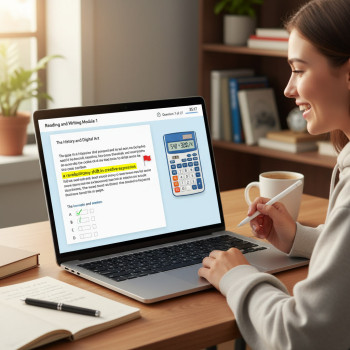Why Motivation Dips Midway Through SAT Prep (and How to Bounce Back)
Picture this: you start SAT prep with energy, color-coded sticky notes, and a playlist that says, “I am unstoppable.” Weeks pass. You take a practice test, celebrate a little, then keep going. But sometime around week six or eight, the playlist feels tired, the sticky notes peel away, and you find yourself scrolling your phone during what used to be study time. You are not broken. This is a stage most students hit. The slump is common, understandable, and — most importantly — beatable.
This article walks through why motivation often fades midway through SAT prep, what really helps revive it, and how to rebuild a study rhythm that fits your life. We will use examples, comparisons, and practical mini-plans you can try immediately. If you want some tailored help, you will also see where Sparkl’s personalized tutoring and AI-driven insights naturally fit to accelerate a comeback.

Why the Slump Happens: The Psychology Behind Midway Motivation Dips
There are predictable psychological forces at work when motivation wanes. Understanding them helps you choose the right response rather than blaming yourself. Here are the main causes:
- Effort-Outcome Imbalance: Early on, small investments yield obvious progress. As material gets harder or the novelty wears off, the same hours produce smaller perceptible gains. Our brains dislike that perceived drop in efficiency.
- Habituation and Monotony: Doing the same routine day after day reduces excitement. Even useful habits can become dull if there is no variety.
- Plateaus and Frustration: Test scores don’t rise in a straight line. Plateaus can feel like failure, even when they’re normal stages in skill building.
- Burnout and Decision Fatigue: Constant studying without well-timed rest depletes mental energy. Small choices — like when to practice or which problem to solve — become harder.
- Unclear or Misaligned Goals: Vague goals like “get better” are not as motivating as specific, measurable targets. The SAT is long-range; lacking short-term checkpoints makes it easy to drift.
- Life Intrusions: Sports seasons, social events, family responsibilities, and school projects all compete for attention. Mid-prep often coincides with other commitments intensifying.
- Anxiety and Perfectionism: When students feel pressure to be flawless, early mistakes or slow progress can trigger avoidance rather than action.
A quick real-world example
Maya began studying six months before the test. Weeks 1–4 felt energizing: she learned strategies, improved a few question types, and saw immediate gains on practice sections. By week 7 she was missing the same question types and started skipping hard practice sections. She felt guilty and slowed down. What happened wasn’t a lack of ability — it was a combination of a plateau, boring repetition, and no clear short-term milestone to chase.
How to Tell If You Have Hit the Midway Slump
Not every dip is a slump. Here are signs that you are in the typical midway motivation slide:
- You delay or skip practice sessions more often than not.
- You study but often feel distracted, and retention drops.
- You notice irritability or fatigue tied to study times.
- You stop checking progress or avoid practice tests because results feel discouraging.
Practical Fixes: Rebuilding Momentum Without Starting Over
Slumps are not a reason to panic; they are invitations to adjust. Below are changes you can make that require modest effort but return big motivation gains.
1. Redefine Progress With Micro-Goals
Instead of vague aims like “raise my score,” set micro-goals that are immediate and measurable. Examples:
- Master one Algebra topic this week: linear inequalities, with five timed problems each day.
- Improve reading paragraph mapping: 4 active-reading passes per practice passage.
- For one practice test, focus only on timing — aim to reduce time spent on the last 10 questions of a section by 20%.
Micro-goals give you small wins to celebrate, which fuels motivation. They also make progress visible in ways that raw score changes sometimes do not.
2. Create Variety: Mix Skills, Formats, and Contexts
Switching formats prevents boredom and builds more robust skills. Swap a section practice for a set of problem explanations or a tidied error-log review. Try different methods:
- Alternate between timed sections, untimed focused practice, and explanation writing for answers you miss.
- Practice with paper one day and a digital interface another day to build comfort with both.
- Use error logs to organize a “targeted rematch” of your worst question types.
3. Deliberate Practice Beats More Hours
Quality matters more than quantity. Deliberate practice means focusing on weaknesses with clear feedback loops. If you keep repeating weak question types in the same way, the brain does not learn efficiently. Instead:
- Break down problems into steps and practice the sub-skills that are failing.
- Explain answers aloud or write them down to deepen understanding.
- Use spaced repetition to return to concepts multiple times, not in a single cram session.
4. Build an Accountability System
External accountability reduces the friction of starting. Options include study partners, group check-ins, or a coach. This is a natural place where Sparkl’s personalized tutoring can help: a tutor provides 1-on-1 guidance, tailored study plans, and regular check-ins that turn good intentions into consistent practice. Accountability is not about pressure; it is about predictable support and feedback.
5. Plan Smart Breaks and Recovery
Rest is not wasted time — it is part of learning. Scheduled breaks, a full day off per week, and micro-rests during study blocks keep cognitive resources high. Techniques include:
- Pomodoro approach: 25–50 minutes work, 5–10 minutes rest, with a longer break after several cycles.
- Active rest: light exercise, a walk, or a hobby to reset the mind.
- Sleep prioritization: 7–9 hours per night amplifies memory consolidation and problem-solving.
Tools and Routines That Help Reignite Progress
Below are concrete routines and tools you can adopt today. Try one improvement for two weeks and observe how motivation shifts.
Structured Weekly Routine
| Day | Primary Focus | Example Tasks | Time |
|---|---|---|---|
| Monday | Targeted Math Practice | 30 min on weak topic, 20 min review of errors | 1.5 hours |
| Tuesday | Reading Strategies | 3 passages with mapping, 10 min summary aloud | 1.5 hours |
| Wednesday | Grammar & Writing | Grammar drills, sentence correction walkthroughs | 1 hour |
| Thursday | Mixed Practice | Mixed section, timed, review mistakes | 1.5–2 hours |
| Friday | Concept Reinforcement | Flashcards, spaced repetition, quick review | 1 hour |
| Saturday | Full Practice Test or Section Retest | Full-length practice or two timed sections | 3–4 hours |
| Sunday | Rest & Light Review | One hour light review, plan for next week | 1 hour |
This schedule balances intensity and recovery. If life gets busy, prioritize small high-value tasks: a single focused error review beats unfocused hours.
Example: How to Turn a Plateau Into a Path Forward
Suppose your reading score stalls despite doing many passages. A better plan than more passages might be:
- Analyze the last 20 missed questions to detect patterns — timing, question type, passage topic.
- Choose two tactics to work on, such as main-idea mapping and evidence spotting.
- Spend one week doing 10 quick practice items focused only on evidence questions, then retest on a full section to measure impact.
This method emphasizes targeted change and objective measurement, which reduces the discouraging sense of randomness.
Data-Backed Tips That Really Help
Research on learning suggests several evidence-based practices to keep motivation high and learning efficient:
- Spacing effect: distribute practice over time rather than massing it. Short, repeated sessions beat one long cram.
- Interleaving: mix problem types so that retrieval and discrimination improve; this builds flexible skills.
- Immediate feedback: correct mistakes quickly to avoid reinforcing errors.
- Active recall: closing notes and trying to reproduce solutions strengthens memory more than passive review.
In practice, that looks like short, frequent practice with immediate review, not marathon studying that leaves you exhausted and unmotivated.
When to Bring in Expert Help
Sometimes the fastest path out of a slump is a conversation with someone who sees your pattern and can help reframe it. Signs you might benefit from expert guidance:
- You’ve tried several routines and nothing has changed after two to three weeks.
- You cannot identify the core weaknesses in your mistakes.
- Motivation is collapsing into avoidance and anxiety.
Sparkl’s personalized tutoring can be helpful here. A good tutor or coach provides 1-on-1 guidance, tailored study plans, and AI-driven insights to prioritize the most impactful next steps. They can reframe plateaus as expected stages and design exercises to convert frustration into measurable progress.
Two Simple Plans to Try This Week
Pick one of these reset plans based on how much time you have. They are designed to restore momentum without overwhelming you.
| Plan | Duration | Core Steps | Expected Outcome |
|---|---|---|---|
| Mini Reset | 3 days |
|
Clarity on weaknesses and renewed focus |
| Seven-Day Momentum Builder | 7 days |
|
Stronger study rhythm and measurable improvement |
A note about timing and energy
Pick studying times that align with your natural energy peaks. Many students do their best analytic work in the morning; others are sharper late afternoon. Test what works and protect that time.

Handling the Emotional Side: Compassion and Perspective
Motivation is a feeling, not a moral evaluation. Treat dips like wind shifts, not character flaws. Here are emotional tools that work:
- Reframe setbacks as feedback. An incorrect answer is information, not an indictment.
- Use self-compassion. Talk to yourself like you would to a friend in the same situation.
- Limit all-or-nothing thinking. A bad practice test doesn’t erase months of effort.
- Keep future self in mind: the investment is temporary, and gains compound.
If stress or anxiety starts to feel unmanageable, step back and seek help from a counselor or tutor who can reduce overwhelm and help you build a calmer plan.
Final Checklist: What to Do When Motivation Dips
Here’s a compact checklist you can run through the next time you notice a slump:
- Identify the cause: boredom, plateau, exhaustion, or life events?
- Pick a single micro-goal for the next seven days.
- Change one thing about your routine to add variety.
- Schedule smart breaks and protect sleep.
- Seek accountability: study buddy, coach, or a tutor for a short check-in.
- Measure change after one week and iterate.
Closing thought
Midway slumps in SAT prep are normal and fixable. Think of prep as a series of experiments: tune one variable, observe the result, and repeat. You do not need to overhaul everything at once. Tiny shifts in goals, routine, feedback, and rest can restore momentum faster than sheer willpower.
If you want a faster route back to motivation, consider a short consultation with a tutor who can diagnose your pattern and build a tiny, targeted plan. Sparkl’s personalized tutoring offers 1-on-1 guidance, tailored study plans, expert tutors, and AI-driven insights to help students focus on the highest-impact improvements. Sometimes a fresh perspective is the spark that turns a slump into steady progress.
Remember: consistent, focused practice — not heroic all-nighters — wins on test day. You have already done the hard part by starting. Now apply a few precise changes, celebrate small wins, and keep moving forward. You’ve got this.



















No Comments
Leave a comment Cancel